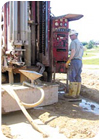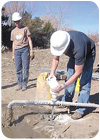Willard decided to shoot his own turkey for Thanksgiving. He got out granddaddy's old double 12 and headed for what he figured was prime turkey country. Sure enough, he spied one pretty quick. BLAM! Got him too. You shoulda seen all those other “hunters” haul-tail out of that Winn Dixie … Sorry folks, I couldn't resist that one!
Where was I? Oh yeah, differential sticking. First, the definition: Differentially stuck pipe is a condition where part of the O.D. of the drill string is exposed to the natural pressure of the formation, and part of it is exposed to the hydrostatic head of the mud in the hole. The symptoms are full circulation but inability to rotate or reciprocate the pipe. In other words, you're stuck.

Most drillers immediately start pulling on the pipe harder and harder 'til they realize they ain't got enough rig. There's a good reason for this, given these conditions:
- Depth: 300 feet
- Static formation water level in the formation: 200 feet = 43.32 psi formation pressure
- Mud in the hole: 10.5 ppg = 163.8 psi head on the hole.

One-third of this is 6.22 inches. When you square 6.22, it means that you've got 38.69 square inches of collar exposed to the formation per inch. With a 20-foot collar, this means 9,285.6 square inches of collar exposed for formation pressure. At a differential of 120.48 psi, the force required to pull free would be 1,118,729 pounds! No wonder the rig won't pull it!
What to do about it? The first and most important thing to do is prevention. Good mud and good solids control go a long way. Good mud will build a thin, tough wall cake that is resistant to leaking and isolate the drill string from the natural pressure of the hole. A good solids control program will help keep mud weight down and wall cake thinner and tougher.
Mechanical solids separation is the most effective way to control mud properties. Shale shakers and desanders beat the heck out of a big ol' strip mine in the customer's yard!

If you still are not free, there is another trick I've occasionally used over the years. You can aerate the mud to lighten the hydrostatic head.
To do this, tie the compressor into the standpipe. Get the mud pump running at a good circulation rate and SLOWLY add air to the mud going to the hole. At some point, the hydrostatic head of the mud in the hole will be less than the formation pressure and the pipe will be free. Immediately start rotation, shut off the air and condition the hole. This is tricky because there is a fine line between freeing the pipe and having the formation heave in on the drill string.
I've seen situations where none of these methods worked. A lot of drillers will run a tremie line down beside the drill string to try to free it. The problem with this is the tremie usually tries to stay on the free side of the pipe, doing no good at all. You've got to get good mud between the drill string and the wall of the hole. The only way to do this is with wash pipe. Wash pipe is specially sized, flush joint pipe that is bigger than the fish but smaller than the hole. If you haven't done it before, don't try it at home, kids. Improperly run wash pipe is the best way I know to stack a fish on a fish and junk a hole, but run right, it is a lifesaver. The professional fishing tool companies have the pipe and the expert advice to get-er-done.
Hope this helps. Remember the three Ps: planning, preparation and prevention. In the meantime, I'm still spitting #4 buckshot out of Willard's turkey leg! ND



Report Abusive Comment